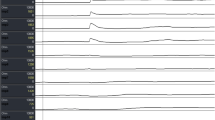Abstract
Background
Artificial intelligence (AI) has potential to streamline interpretation of pH-impedance studies. In this exploratory observational cohort study, we determined feasibility of automated AI extraction of baseline impedance (AIBI) and evaluated clinical value of novel AI metrics.
Methods
pH-impedance data from a convenience sample of symptomatic patients studied off (n = 117, 53.1 ± 1.2 years, 66% F) and on (n = 93, 53.8 ± 1.3 years, 74% F) anti-secretory therapy and from asymptomatic volunteers (n = 115, 29.3 ± 0.8 years, 47% F) were uploaded into dedicated prototypical AI software designed to automatically extract AIBI. Acid exposure time (AET) and manually extracted mean nocturnal baseline impedance (MNBI) were compared to corresponding total, upright, and recumbent AIBI and upright:recumbent AIBI ratio. AI metrics were compared to AET and MNBI in predicting ≥ 50% symptom improvement in GERD patients.
Results
Recumbent, but not upright AIBI, correlated with MNBI. Upright:recumbent AIBI ratio was higher when AET > 6% (median 1.18, IQR 1.0–1.5), compared to < 4% (0.95, IQR 0.84–1.1), 4–6% (0.89, IQR 0.72–0.98), and controls (0.93, IQR 0.80–1.09, p ≤ 0.04). While MNBI, total AIBI, and the AIBI ratio off PPI were significantly different between those with and without symptom improvement (p < 0.05 for each comparison), only AIBI ratio segregated management responders from other cohorts. On ROC analysis, off therapy AIBI ratio outperformed AET in predicting GERD symptom improvement when AET was > 6% (AUC 0.766 vs. 0.606) and 4–6% (AUC 0.563 vs. 0.516) and outperformed MNBI overall (AUC 0.661 vs. 0.313).
Conclusions
BI calculation can be automated using AI. Novel AI metrics show potential in predicting GERD treatment outcome.




Similar content being viewed by others
References
Gyawali CP, Kahrilas PJ, Savarino E, et al. Modern diagnosis of GERD: the Lyon Consensus. Gut. 2018;67:1351–62.
Frazzoni M, Savarino E, de Bortoli N, et al. Analyses of the post-reflux swallow-induced peristaltic wave index and nocturnal baseline impedance parameters increase the diagnostic yield of impedance-pH monitoring of patients with reflux disease. Clin Gastroenterol Hepatol. 2016;14:40–6.
Patel A, Wang D, Sainani N, et al. Distal mean nocturnal baseline impedance on pH-impedance monitoring predicts reflux burden and symptomatic outcome in gastro-oesophageal reflux disease. Aliment Pharmacol Ther. 2016;44:890–8.
Rengarajan A, Savarino E, Della Coletta M, et al. Mean nocturnal baseline impedance correlates with symptom outcome when acid exposure time is inconclusive on esophageal reflux monitoring. Clin Gastroenterol Hepatol. 2020;18:589–95.
Jin EH, Lee D, Bae JH, et al. Improved accuracy in optical diagnosis of colorectal polyps using convolutional neural networks with visual explanations. Gastroenterology. 2020;158:2169–79.
Takenaka K, Ohtsuka K, Fujii T, et al. Development and validation of a deep neural network for accurate evaluation of endoscopic images from patients with ulcerative colitis. Gastroenterology. 2020;158:2150–7.
Patel A, Sayuk GS, Gyawali CP. Parameters on esophageal pH-impedance monitoring that predict outcomes of patients with gastroesophageal reflux disease. Clin Gastroenterol Hepatol. 2015;13:884–91.
Sifrim D, Roman S, Savarino E, et al. Normal values and regional differences in oesophageal impedance-pH metrics: a consensus analysis of impedance-pH studies from around the world. Gut. 2020; https://doi.org/10.1136/gutjnl-2020-322627.
Martinucci I, de Bortoli N, Savarino E, et al. Esophageal baseline impedance levels in patients with pathophysiological characteristics of functional heartburn. Neurogastroenterol Motil. 2014;26:546–55.
Rogers BD, Patel A, Wang D, et al. Higher esophageal symptom burden in obese subjects results from increased esophageal acid exposure and not from dysmotility. Clin Gastroenterol Hepatol. 2020;18:1719–26.
Hoshikawa Y, Sawada A, Sonmez S, et al. Measurement of esophageal nocturnal baseline impedance: a simplified method. J Neurogastroenterol Motil. 2020;26:241–7.
Sifrim D, Castell D, Dent J, et al. Gastro-oesophageal reflux monitoring: review and consensus report on detection and definitions of acid, non-acid, and gas reflux. Gut. 2004;53:1024–31.
Gyawali CP, Rogers B, Frazzoni M, et al. Inter-reviewer variability in interpretation of pH-impedance studies: the Wingate Consensus. Clin Gastroenterol Hepatol. 2020;S1542–3565(20):31230–1. https://doi.org/10.1016/j.cgh.2020.09.002.
Sifrim D, Silny J, Holloway RH, et al. Patterns of gas and liquid reflux during transient lower oesophageal sphincter relaxation: a study using intraluminal electrical impedance. Gut. 1999;44:47–54.
Gyawali CP. Redeeming clinical value of esophageal pH impedance monitoring. Clin Gastroenterol Hepatol. 2016;14:47–9.
Bengtsson M, Ohlsson B, Ulander K. Development and psychometric testing of the visual analogue scale for irritable bowel syndrome (VAS-IBS). BMC Gastroenterol. 2007;7:16.
Guyatt GH, Townsend M, Berman LB, et al. A comparison of Likert and visual analogue scales for measuring change in function. J Chronic Dis. 1987;40:1129–33.
Author information
Authors and Affiliations
Contributions
BDR: study concept, data analysis, drafting of manuscript, and critical review of manuscript; SS: creation of AI algorithm, data analysis, and critical review of manuscript; KG: creation of AI algorithm, data analysis, and critical review of manuscript; AP: data collection and final review of manuscript; ES: data collection, key intellectual content, critical review of manuscript; SR: key intellectual content and critical review of manuscript; DS: key intellectual content and critical review of manuscript; CPG: study concept, data analysis, key intellectual content, drafting, and finalization of manuscript.
Corresponding author
Ethics declarations
Conflict of interest
No conflicts of interest exist. Partial funding through the Thomas and Mary Eckert Fellowship Clinical Research Fund, through the Division of Gastroenterology, Washington University School of Medicine, St. Louis, awarded to BDR. BDR: no disclosures; SS: no disclosures; KG: co-founder of ClearifiRx; ES: Lecture Fee: Medtronic, Takeda, Janssen, MSD, Abbvie, Malesci; Consulting: Medtronic, Takeda, Janssen, MSD, Reckitt Bencikser, Sofar, Unifarco, SILA, Oftagest ; SR: consulting Medtronic, research support Diversatek Healthcare, Medtronic; DS: research grants: Reckitt Benckiser UK, Jinshan Technology China, Alfa Sigma Italy; CPG: Consulting: Medtronic, Diversatek, Isothrive, Ironwood, Quintiles.
Additional information
Publisher's Note
Springer Nature remains neutral with regard to jurisdictional claims in published maps and institutional affiliations.
Rights and permissions
About this article
Cite this article
Rogers, B., Samanta, S., Ghobadi, K. et al. Artificial intelligence automates and augments baseline impedance measurements from pH-impedance studies in gastroesophageal reflux disease. J Gastroenterol 56, 34–41 (2021). https://doi.org/10.1007/s00535-020-01743-2
Received:
Accepted:
Published:
Issue Date:
DOI: https://doi.org/10.1007/s00535-020-01743-2




